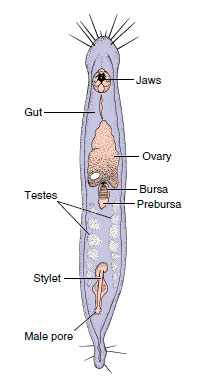Phylum Gnathostomulida
 |
| Figure 14-28 Gnathostomula jenneri (phylum Gnathostomulida) is a tiny member of the interstitial fauna between grains of sand or mud. Species in this family are among the most commonly encountered jaw worms, found in shallow water and down to depths of several hundred meters. |
Phylum Gnathostomulida
The first species of the Gnathostomulida (nath´o-sto-myu´lid-a) (Gr. gnathos, jaw, + stoma, mouth, + L. ulus, dim. suffix) was observed in 1928 in the Baltic, but its description was not published until 1956. Since then jaw worms have been found in many parts of the world, including the Atlantic coast of the United States, and over 80 species in 18 genera have been described.
Gnathostomulids are delicate wormlike animals and are 0.5 to 1 mm long (Figure 14-28). They live in interstitial spaces of very fine sandy coastal sediments and silt and can endure conditions of very low oxygen. They often occur in large numbers and frequently in association with gastrotrichs, nematodes, ciliates, tardigrades, and other small forms.
Lacking a pseudocoel, a circulatory system, and an anus, gnathostomulids show some similarities to turbellarians and were at first included in that group. However, their parenchyma is poorly developed, and their pharynx is reminiscent of the rotifer mastax. Their pharynx is armed with a pair of lateral jaws used to scrape fungi and bacteria off the substratum. And, although the epidermis is ciliated, each epidermal cell has but one cilium, a condition rarely found in the less derived bilateral animals except in some gastrotrichs.
Gnathostomulids can glide, swim in loops and spirals, and bend the head from side to side. Sexual stages may include males, females, and hermaphrodites. Fertilization is internal.




